Rodin Works: adam and eve |
|||
|
Only
as the second version was nearing completion he started with
'Eve'. The figure of Eve was the first life-size female figure Rodin modeled, after his
'Bacchante' had been destroyed by accident. "..sunburned skin, warm, with the bronze reflections of
the women of sunny lands; her movements were quick and feline, with the
lissomeness and grace of a panther; all the strength and splendor of
muscular beauty, and that perfect equilibrium, that simplicity of bearing
which makes great gesture. At that time I was working on my statue Eve. Edmond de Goncourt, who saw an unfinished 'Eve' in Rodin's studio in April 1886, reported: [Rodin] shows us also a robust roughcast [sketch] of a nude
woman, an Italian, a short and supple creature, a panther, as he puts it,
which he says with regret in his voice he cannot finish because on of his
pupils, a Russian, fell in love with her and married her."
In most Rodin catalogues, it is assumed Rodin was talking about the Abruzzezzi sisters, Adèle and Anna, Anna being the darker type referred to. By now, archive research has established that Anna impossibly could have been the pregnant model for 'Eve'; probably, Rodin - having his conversation with Dujardin-Beaumetz only twenty years after - had mixed up his recollection of the Abruzzezzi sisters with that of another Italian model, Carmen Visconti. As Lynne Ambrosini demonstrates, Anna Abruzzezzi was born in Rome in 1874, so that between 1881 and 1886, she had been far too young to be pregnant. As a matter of fact, Anna did have a pregnancy, but only in 1895, while having a love affair with the French painter Auguste François Gorguet during her vacation in Rome. Gorguet terminated the affair and refused to support the young mother; in January 1897, an outraged Anna tried to throw biting acid into her unloyal lover's face, thereby mutilating herself more than him. She was arrested and convicted; Rodin and other artists created a fund to support her.
Carmen Visconti of Fiesole, on the other hand, did have a love
relationship with a Russian painter, Nicolas Enilioti, who took her on
holidays to Chevreuse. In several newspaper interviews, Carmen - a dark
type as well - reported she had posed for 'Eve', 'The Kiss' and 'The Wave'
('Toilette of Venus'). The large 'Eve' version, though unfinished, was cast in bronze all the
same, still showing the metal strut at the ankle that had helped stabilize
the plaster construction: Like in 'The
Prodigal Son', Rodin fancied preserving such details from his creative Working with a thinner English model, Rodin executed also a smaller version of 'Eve' in a manner more smooth and feminine than the roughly modeled surface of the large-scale version.
"From a distance she seems to be enfolded in her arms, with hands turned to the outside as if to push away everything, even her own changing body." Both 'Adam' and 'Eve' have poses based on a pronounced contrapposto, much in the style of Michelangelo, one foot resting on an elevation.'Eve's' body shows a gentle S-curve, with the arms crossed over the breast and a downcast head. Her protective attitude expresses her shame and remorse after the Fall: "Ashamed of her fault, shrinking in fear, vaguely anguished not so much by remorse for her sin but by the idea of creating other human beings who will suffer in the future, (... the big) Eve is a bronze of an extraordinary aspect and all of Rodin is in it." [Camille Mauclair, Auguste Rodin, 1918] In Rodin's work, 'Eve' does not appear as the originator of human sin, as a representation of evil; rather she represents the frailty of the human condition, exposed to threats and seduction. As a variation of 'Adam' with a less distorted attitude, Rodin executed 'The Three Shades': a triple representation of the same figure, mounted on top of 'The Gates of Hell'.
|
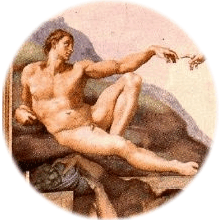
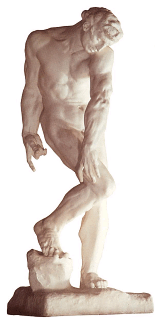
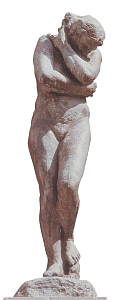
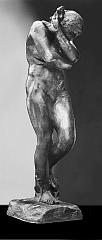
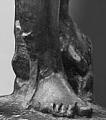 Altogether, she had modeled for Rodin during
a period of 13 years, including the early 1880's.
Altogether, she had modeled for Rodin during
a period of 13 years, including the early 1880's.
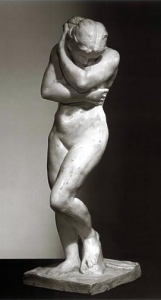 process.
process.